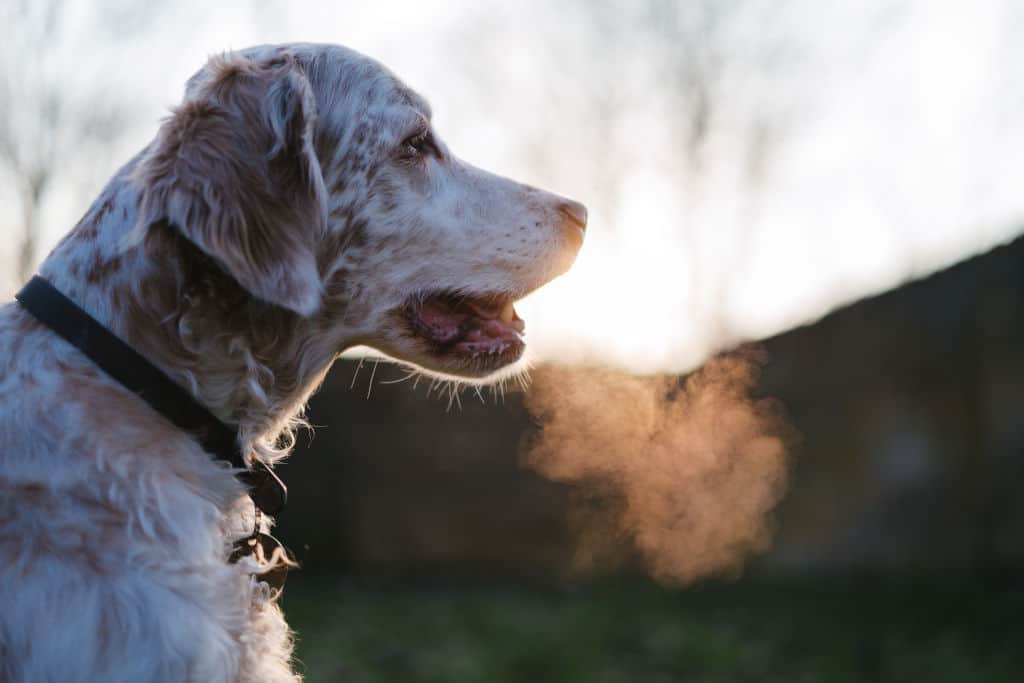You may see water droplets developing when looking at your own or your dog’s breath. And you might be asking yourself, what’s the reasoning behind this?
Warm air can hold more water than cold air. When you exhale, you are exhaling air that has been warmed and enriched by your body. It cools when it touches the outside air that can’t contain as much water. Because of this, you can see your own and your dog’s breath.
When there is high humidity in the air, you can see your dog’s breath, even in warm weather.

At What Temperature Can You See Your Breath
The temperatures at which you can see your breath can reach 70F or 21C, but there is no set temperature. When you breathe, the moisture content of the air, along with your breath, must exceed 100% humidity, resulting in condensation.
When you see your breath, the moisture in it cools, and as a result, it condenses from a gas to a liquid that refracts light.
The highest amount of water vapor that may be dissolved in the air is known as 100% humidity. The amount of water the air can store decreases as the temperature drops. So, as your high temperature, high humidity breath cools, it tries to get rid of the water it can no longer keep.
If the colder air isn’t too humid, there’s “space” for the extra water. If the colder is highly humid, it won’t have as much room, and all of the additional water will condense as visible droplets, which is why you can see your breath.
But what about indoors? Many wonder if the same principles apply within the confines of our homes.
Why Can I See My Dogs Breath Inside My House?
The reason why you can see breath indoors has to deal with temperature and moisture content differences. Indoor air may be dryer or damper at times. That is caused by high humidity. Even if it’s pretty warm (or not cold), you may be able to see your breath.
Dogs cool off by air circulation. In cooler condensed air, warmer moist air is almost always seen (usually no moisture or humidity). It’s just a hot-to-cool transition.
You can experiment by exhaling into any mirror or flat surface. The moisture from your exhale will collect on the surface and disperse as it cools. That is precisely what is happening with your dog, but the air from the dog’s lungs is more visible because of the severe temperature fluctuation and humidity volume.
There is always a physical reason for everything and why you can see your own or your dog’s breath. It’s not a ghost. It’s physics.
How Do Dogs Normally Breathe?
When awake, dogs can breathe through either their mouths or their nose. They breathe through their noses when sleeping, for the most part. As a result, if their nose is blocked, dogs will wake up, open their mouth to breathe, and then fall back asleep.
Neither dogs nor cats breathe through their mouths constantly. Instead, they breathe primarily through their noses, like all other mammals.
In addition, dogs frequently pant. That is not breathing but cooling oneself—the canine equivalent of air conditioning.
Fur-bearing animals do not sweat from their skin since it causes their fur to become moist, moldy, and tangled. As a result, they have other options for cooling.
FAQs
Can Dogs Breathe Through Their Paws?
Dogs lack sweat glands in their bodies. Instead, sweat glands are located in their paws. Panting is the most effective strategy for them to control their body temperature. The dog doesn’t breathe through its paws but instead sweats through them and its tongue.
Because dogs cannot sweat through their skin like humans, they pant and let their tongues dangle out of their mouths to maintain body temperature. They pant to circulate cool air through their bodies.
Why does my dog’s breath appear warm or hot?
A dog’s internal body temperature is naturally higher than humans. Upon exhalation, the warm moisture-laden air can feel especially warm, particularly in contrast to the surrounding environment, which is why your dog’s breath feels hot.
What foods cause bad breath in dogs?
Meat, bones, and other food items get lodged in their teeth and stink up their mouth. The meal may not be adequately digested and emits a foul odor. Please consult your veterinarian about what food to feed your dog and check their teeth.
Alex, a passionate animal lover, has experience in training and understanding animal behavior. As a proud pet parent to two dogs and three cats, he founded AnimalReport.net to share insights from animal experts and expand his knowledge of the animal kingdom.




